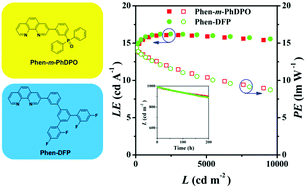High Tg small-molecule phenanthroline derivatives as a potential universal hole-blocking layer for high power-efficiency and stable organic light-emitting diodes†
Abstract
Electron-transport/hole-blocking materials are beneficial for improving OLED efficiency through promoting hole/electron recombination. In this contribution, we present a new phenanthroline derivative Phen-DFP by appending 3-(3,5-bis(2,4-difluorophenyl)phenyl)phenyl to 1,10-phenanthroline, based on the recent triarylphosphine oxide–phenanthroline molecular conjugate Phen-m-PhDPO. Phen-DFP possesses a Tg of 95 °C, a LUMO/HOMO level of ca. −3.0/−6.6 eV and a μe of ca. 2.5 × 10−5 cm2 V−1 s−1 @ E = 5 × 10 5 V cm−1. It was evaluated as a potential hole blocker for pin sky blue fluorescent, and green and red phosphorescent OLEDs, in comparison with Phen-m-PhDPO and TPBi. Remarkably, the modified DSA-Ph based fluorescent OLEDs that contained Phen-m-PhDPO and Phen-DFP produced a luminous and power efficiency of ∼16 cd A−1 and 13 lm W−1 @1000 cd m−2 with a primitive lifetime t90 ≈ 200 h @1000 cd m−2 under constant current driving. In contrast with the sky blue fluorescent and red phosphorescent OLEDs, the inferior luminous efficiency of the green Phen-DFP phosphorescent OLEDs was attributed to the lower triplet energy of Phen-DFP with respect to Phen-m-PhDPO and TPBi. These comprehensive studies may contribute to the understanding of the complex trade-offs among electron injection/transport, triplet energy, hole blocking, OLED luminous/power efficiency and operational stability, huddled around a hole blocker.



 Please wait while we load your content...
Please wait while we load your content...